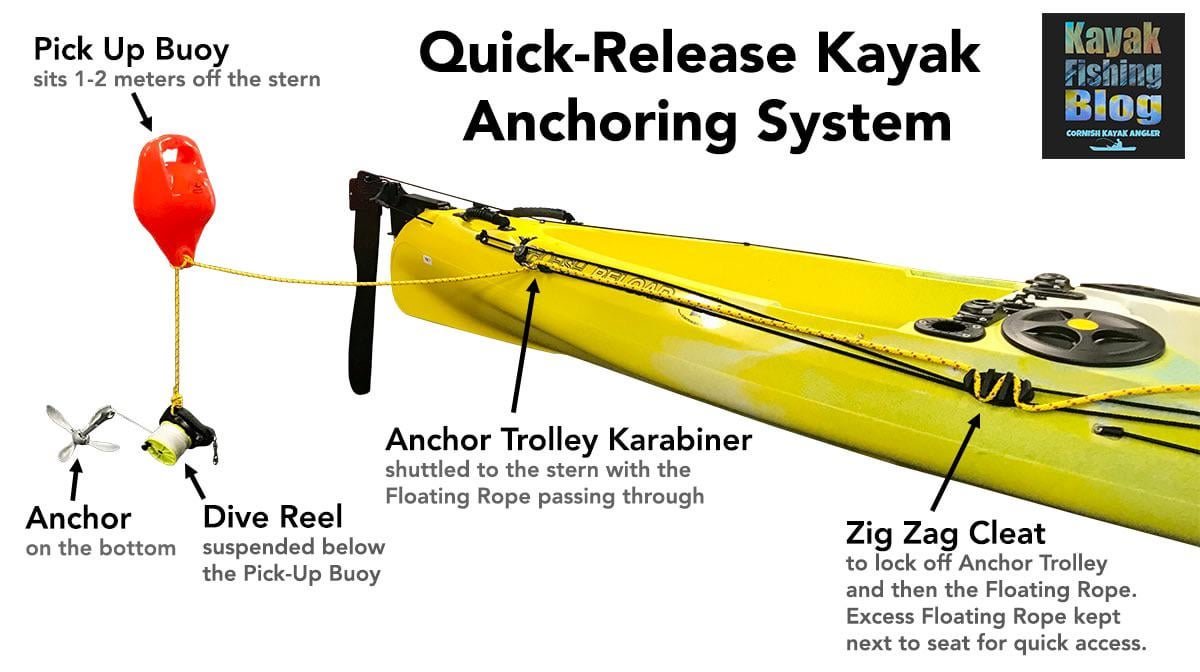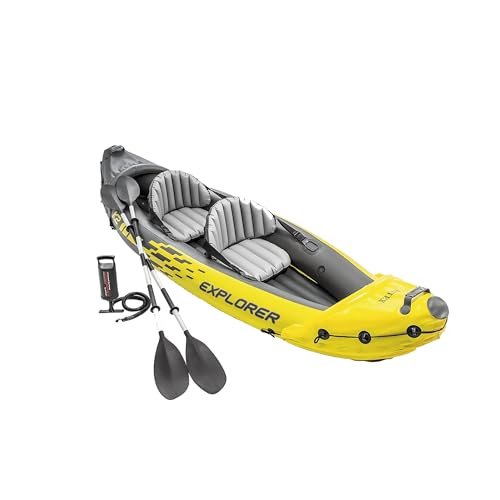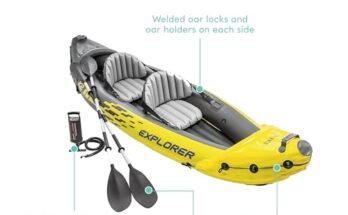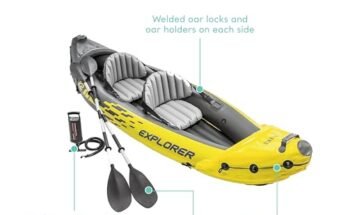If you love kayaking, you know how important it is to stay steady in one spot. But have you ever struggled to keep your kayak from drifting?
That’s where a kayak anchor comes in. Using a kayak anchor might seem tricky at first, but once you get the hang of it, it can make your time on the water much more relaxing and enjoyable. You’ll learn exactly how to use a kayak anchor the right way, so you can hold your position with ease and focus on what really matters—your adventure.
Keep reading, and you’ll discover simple tips that will change the way you kayak forever.

Choosing The Right Anchor
Using a kayak anchor helps keep your kayak in one place. Picking the right anchor makes your time on the water safer and easier.
Different anchors work better in different water and weather conditions. It is important to know what anchor fits your needs.
Types Of Kayak Anchors
Kayak anchors come in several types. Each type works well in certain water and ground conditions.
- Fluke anchors: Good for sandy or muddy bottoms.
- Grapnel anchors: Compact and good for rocky areas.
- Claw anchors: Hold well in soft bottoms like mud or sand.
- Plow anchors: Designed to dig in firmly on many surfaces.
Anchor Size And Weight
Choose an anchor size that fits your kayak and water conditions. Too small an anchor won’t hold well. Too large is heavy to carry.
Heavier anchors hold better in strong currents or wind. Lighter anchors are easier to use in calm water.
- Small kayaks: 1 to 3 pounds anchor weight.
- Medium kayaks: 3 to 5 pounds anchor weight.
- Large kayaks: 5 to 8 pounds or more.
Material Considerations
Anchors are made from metal or plastic. Metal anchors are strong but can rust. Plastic anchors are light but less durable.
Choose materials that last long and suit your water type. Saltwater needs rust-resistant anchors like stainless steel or coated metal.
- Stainless steel: Rust-resistant and strong.
- Galvanized steel: Coated to resist rust.
- Aluminum: Lightweight but less strong.
- Plastic/composite: Light and good for soft bottoms.
Preparing Your Kayak For Anchoring
Anchoring your kayak properly helps you stay in place on the water. It also keeps you safe and comfortable while fishing or resting. Preparing your kayak for anchoring takes some simple steps.
Learn how to set up your kayak with an anchor trolley, attach the anchor rope and chain, and gather the right safety gear and tools.
Installing Anchor Trolley System
The anchor trolley system lets you move the anchor line along the side of your kayak. This helps control where your kayak faces when anchored. To install it, attach the trolley line from the bow to the stern.
- Secure the trolley line with strong cord or wire
- Install pulleys at both ends for smooth movement
- Attach cleats or hooks to hold the line in place
- Test the system by sliding the line from front to back
Attaching Anchor Rope And Chain
Use a rope and chain to connect the anchor to your kayak. The chain adds weight and prevents the rope from rubbing on rocks or rough surfaces. Attach the rope to the trolley line for easy control.
| Item | Purpose |
| Anchor Rope | Connects anchor to kayak |
| Anchor Chain | Protects rope and adds weight |
| Carabiner or Shackle | Connects rope and chain securely |
| Anchor | Keeps kayak in place |
Safety Gear And Tools
Always carry safety gear and tools before anchoring. These items help you handle problems and stay safe on the water.
- Personal flotation device (PFD)
- Knife for cutting rope if needed
- Gloves to protect your hands
- Extra rope in case of damage
- Anchor retrieval tool for easy anchor release
Selecting The Best Spot To Anchor
Choosing the right place to drop your kayak anchor is key for safety and comfort. You need to think about water depth, the type of bottom, and natural forces like wind and current.
Finding a good spot helps keep your kayak steady and protects the environment around you. Let’s explore what to check before anchoring.
Assessing Water Depth And Bottom Type
Check how deep the water is before you drop the anchor. It should be deep enough so the anchor holds well but not so deep that your rope is too long.
- Ideal depth is usually 6 to 15 feet for most kayak anchors.
- Look for sandy or muddy bottoms because anchors grip better there.
- Avoid rocky or heavily vegetated areas that can tangle your anchor.
Avoiding Hazards And Sensitive Areas
Steer clear of places that can damage your kayak or harm nature. These include underwater cables, reefs, and protected wildlife zones.
| Hazard | Why to Avoid | What to Do |
|---|---|---|
| Underwater cables | Can snag anchor and cause damage | Look for markers and avoid these zones |
| Coral reefs | Delicate and easy to harm | Anchor away from reefs to protect them |
| Wildlife habitats | Disturbs animals and plants | Respect signs and keep distance |
Considering Wind And Current
Wind and water flow can push your kayak while anchored. Pick a spot that helps keep you safe and steady.
- Face your kayak into the wind to reduce drift.
- Avoid spots with strong currents that pull sideways.
- Watch the weather forecast for sudden changes.
Deploying The Anchor
Using a kayak anchor helps keep your kayak steady in one spot. This is useful for fishing or resting.
Knowing how to deploy the anchor properly keeps you safe and prevents your kayak from drifting.
Proper Techniques For Dropping Anchor
Hold the kayak steady before dropping the anchor. Do not throw the anchor far away.
Lower the anchor slowly into the water. Let it settle on the bottom to grip well.
- Face the kayak into the wind or current
- Drop the anchor straight down, not forward or backward
- Give the anchor time to catch on the bottom
Managing Anchor Line Length
The length of the anchor line affects how well the anchor holds. Use more line in deep water.
A good rule is to let out three times the water depth. This gives the anchor a better hold.
- Measure the water depth before dropping the anchor
- Let out enough line to reach the bottom with slack
- Adjust the line if the kayak drifts
Securing The Anchor Rope
After dropping the anchor, tie the rope to a strong point on the kayak. This keeps the anchor connected.
Use secure knots that will not slip. Check the rope often for wear or damage.
- Tie the rope to the kayak’s cleat or handle
- Use a bowline or cleat hitch knot for security
- Keep the rope tidy to avoid tangles
Maintaining Stability While Anchored
Keeping your kayak steady while anchored is important for safety and comfort. Wind and water currents can move your kayak, causing instability. Using the right techniques and gear helps you stay in place.
This guide explains how to adjust for changing conditions, use extra gear, and keep track of your kayak’s position to maintain stability.
Adjusting For Wind And Current Changes
Wind and currents push your kayak in different directions. Adjusting your anchor line length and position helps keep the kayak steady. Shortening the line in strong wind can reduce drifting. Letting out more line in calm water allows better holding.
- Check wind direction before anchoring
- Change anchor line length as needed
- Move the kayak to a better spot if drifting continues
- Use natural features like rocks or vegetation for extra protection
Using Drift Socks And Additional Gear
Drift socks slow down your kayak’s movement in water. They work like underwater parachutes. Other gear like anchor floats and cleats can improve stability. Combining these tools helps control kayak drift.
| Gear | Purpose | How to Use |
|---|---|---|
| Drift Sock | Slows kayak drift | Deploy from the side or stern |
| Anchor Float | Keeps anchor line visible | Attach above the anchor on the line |
| Cleats | Secure anchor line | Use to tie off the line firmly |
Monitoring Kayak Position
Watch your kayak’s position regularly to avoid drifting into unsafe areas. Use landmarks or GPS devices to track movement. Adjust your anchor or gear if you notice the kayak moving too much.
- Pick visible landmarks to check position
- Use a GPS for precise tracking
- Reset anchor if drifting increases
- Keep an eye on weather changes
Retrieving The Anchor Safely
Retrieving a kayak anchor is important for safety and convenience. Doing this properly ensures a smooth kayaking experience.
Learn the best ways to bring your anchor up without issues. This will help you avoid accidents and keep your equipment in good condition.
Techniques For Lifting The Anchor
Pull the anchor line steadily to avoid tangles. Using a slow and steady motion helps to lift the anchor without causing sudden movements.
Ensure the kayak is stable while lifting. Keep your body centered to maintain balance.
- Use both hands for a firm grip
- Avoid jerking the line
- Check the line for knots
Handling Snags And Obstacles
If the anchor gets stuck, stay calm. Pull gently in different directions to loosen it.
Do not pull too hard to avoid tipping the kayak. Sometimes reversing the kayak can help free the anchor.
- Assess the situation before pulling
- Try a side-to-side motion
- Consider moving the kayak to a better angle
Stowing The Anchor
Once retrieved, secure the anchor properly. Use the storage area in your kayak to keep it safe.
Make sure the anchor is dry before storing. This prevents rust and keeps your kayak clean.
- Wrap the line neatly
- Check for any damage
- Store in a designated compartment
Common Mistakes To Avoid
Using a kayak anchor can be tricky for beginners. Avoid these common mistakes to ensure a safe and effective experience.
Learning to use a kayak anchor properly helps in keeping your kayak stable. Avoiding mistakes can make your trip more enjoyable.
Overlooking Anchor Weight
Choosing the wrong anchor weight can cause problems. A too-light anchor won’t hold your kayak in place.
An overly heavy anchor is hard to handle. It can make anchoring difficult and tiring.
- Match anchor weight to kayak size
- Consider water conditions
- Test anchor before long trips
Ignoring Environmental Conditions
Weather and water conditions affect anchoring. Strong currents can drag a kayak with a small anchor.
Wind can push your kayak away if the anchor isn’t secure. Always check the environment before setting anchor.
- Check weather forecast
- Observe water currents
- Secure anchor in windy conditions
Improper Rope Management
Poor rope management can lead to tangles. This makes it hard to retrieve your anchor.
Letting the rope float can get it caught in rocks or debris. Keep your rope tidy for easy anchoring.
- Use a rope bag or reel
- Keep rope length appropriate
- Check for knots before use

Tips For Different Kayaking Conditions
Using a kayak anchor helps keep your kayak steady. Different water conditions need different anchoring tips. Knowing how to anchor right keeps you safe and comfortable.
This guide covers anchoring in rivers, lakes, and saltwater. Follow these tips for better control and stability on the water.
Anchoring In Rivers And Streams
Rivers and streams have flowing water. Choose a spot where the current is slow. Avoid strong currents to keep your kayak steady.
Use a heavier anchor to hold in moving water. Let out enough rope so the anchor reaches the riverbed firmly.
- Pick calm pools or eddies to anchor
- Use a heavy anchor for strong currents
- Release enough rope to reach the bottom
- Check the anchor often to prevent drifting
Anchoring In Lakes And Ponds
Lakes and ponds usually have still water. Anchoring here is easier. Choose a soft bottom like mud or sand for the anchor to hold well.
Use a lighter anchor and less rope. Watch the weather and be ready to pull anchor if wind picks up.
- Anchor in soft, flat areas for best hold
- Use light to medium anchor weight
- Adjust rope length to water depth
- Monitor wind and weather changes
Anchoring In Saltwater
Saltwater can be tricky with tides and waves. Choose a spot protected from strong waves. Use a heavy anchor to resist tide movement.
Let out extra rope to allow for tide changes. Check the anchor often and be ready to move if conditions change.
- Pick sheltered areas to anchor
- Use a heavy anchor for tide and waves
- Give extra rope for rising and falling tide
- Watch for changes in tide and wind

Frequently Asked Questions
How Do I Properly Deploy A Kayak Anchor?
To deploy a kayak anchor, choose a stable spot, lower the anchor steadily, and let it settle. Avoid sudden drops to prevent tangling. Secure the anchor line to a strong point on your kayak. This ensures stability and prevents drifting effectively.
What Type Of Anchor Is Best For Kayaks?
The best kayak anchors are lightweight and easy to handle. Common types include mushroom, grapnel, and folding anchors. Choose based on water depth and bottom type. Lightweight, corrosion-resistant anchors are ideal for kayakers seeking convenience and reliability.
How Do I Retrieve A Kayak Anchor Safely?
To retrieve, pull the anchor line steadily while moving toward the anchor. Avoid jerking to prevent tangles or damage. Once the anchor is free, coil the line neatly. This ensures safety and prolongs the anchor’s usability.
Can I Use A Kayak Anchor In Strong Currents?
Yes, but select a heavier anchor suited for strong currents. Ensure the anchor grips firmly to the bottom. Always monitor your position and adjust if drifting occurs. Proper anchor choice and technique are vital in strong current conditions.
Conclusion
Using a kayak anchor keeps your boat steady and safe. It helps you stay in one spot without drifting. Always check the anchor type and the waterbed before dropping it. Practice lowering and raising the anchor to save time. Secure the rope well to avoid losing the anchor.
With patience and care, anchoring becomes easy and useful. Enjoy your time on the water with confidence and control.



